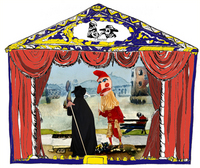Sep 20, 2010
XWave: Control your iPhone with your brain
The XWave is a new technology that uses a single electrode placed on the wearer’s forehead to measure electroencephalography (EEG) data, and converts these analog signals into digital so they can be used to control an external device. The XWave comes bundled with a software that includes a number of brain-training exercises. These include levitating a ball on the iDevice’s screen, changing a color based on the relaxation level of your brain and training your brain to maximize its attention span.
In the company’s own words:
XWave, powered by NeuroSky eSense patented technologies, senses the faintest electrical impulses transmitted through your skull to the surface of your forehead and converts these analogue signals into digital. With XWave, you will be able to detect attention and meditation levels, as well as train your mind to control things. Objects in a game can be controlled, lights in your living room can change colour depending on your mood; the possibilities are limited to only the power of your imagination.

16:05 Posted in Brain training & cognitive enhancement, Brain-computer interface, Wearable & mobile | Permalink | Comments (0) | Tags: brain-computer interface, neurosky, mobile, wearable, eeg, xwave
Apr 17, 2009
MP3 player for unborn babies
Via Repubblica
Canadian design student Geof Ramsay has invented a MP3 player for unborn babies - the "BLABY". By wearing the device, pregnant mothers will be able to play their favourite music to their children. The player consists of a contoured belt that wraps around a mother's waist with three inbuilt vibration speakers playing music into the womb. Its inbuilt speakers transmit the vibrations of music and voice through to the baby in a safe manner, and the mother wearing it can also benefit from three tiny massage mechanisms.

16:51 Posted in Wearable & mobile | Permalink | Comments (0) | Tags: positive technology, music, wearable, mp3
Jan 05, 2008
Portable navigation on mobiles set to take off
EE Times Europe (01/03/2008 8:30 AM EST)
LONDON — Sales of portable navigation devices are set to increase ten-fold over the next eight years, with the huge take-up coming from the the GPS functionality being embedded into mobile phones, according to Telematics Research Group (TRG).
While Garmin and TomTom are predicted to remain global market leaders for portable navigation devices, mobile phone makers such as Nokia, Motorola, LG and Samsung are expected to show the way in the near future, the Minneapolis based market research group suggests in a report on the sector.
TRG sees the worldwide portable navigation market growing from 50 million units in 2007 to more than 500 million units in 2015.
It suggests the change in market leadership is partly due to wireless connectivity opening up new applications and services by bringing together accurate location-based data with advanced POI data including pricing, inventory and user-generated content such as ratings of local businesses.
TRG estimates 30 million dedicated Personal Navigation Devices (PNDs) were sold last year and about 20 million navigation-enabled mobile phones. It estimates that navigation-enabled mobile phones will start outselling dedicated PNDs next year, with the combined segments reaching annual sales of more than 220 million by the end of 2012.
The market researchers suggest that by 2015, Nokia could be selling 180 million devices with GPS capability, followed by Samsung and Motorola (both 70 million), LG (60 million), and TomTom and Garmin both 25 million.
Corresponding figures for last year are said to be 9 million units sold by TomTom, 8 million by Garmin, 7 million by Mitac, 5 million by Nokia and 4 million by Mio/Navman.
"In the years to come navigation-enabled mobile phones will be used for auto navigation, pedestrian navigation and many other types of location-based services," says Egil Juliussen, principal analyst for TRG. "This opens up a new world of services and capabilities".
Recent acquisitions by TomTom and Nokia point the way toward the coming battle for the GPS consumer, according to Juliussen.
"Required for success in the GPS market of the future will be connectivity, inexpensive maps and rich point-of-interest content addresses alone will not be enough", he adds.
Garmin and TomTom are adding connectivity to their devices, he notes, and mobile phone makers are adding maps. "A large volume market for inexpensive, dedicated navigation devices will live on past 2008," Juliussen says, but survival for TomTom and Garmin may mean finding a way to compete for smartphone users.
17:14 Posted in Locative media, Wearable & mobile | Permalink | Comments (0) | Tags: mobile, wearable
Nov 04, 2007
Time Magazine names Apple iPhone `Invention of the Year'

TIME magazine has named the iPhone "Invention of the Year."
19:15 Posted in Wearable & mobile | Permalink | Comments (0) | Tags: mobile, wearable
Oct 07, 2007
Teleglass T4-N wearable monitor
Via Pink Tentacle
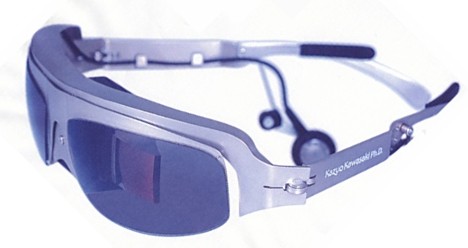
The Teleglass T4-N wearable monitor weighs 30 grams and features titanium frames by eyeglass designer Kazuo Kawasaki. The device supports any NTSC-capable video player (including iPods) and delivers images directly to the eye via a pair of tiny monitors tucked away behind the lenses. The 640 x 480 screen resolution at close proximity simulates the effect of watching a 45-inch screen from 2 meters (6 feet) away.
500 sets are available through the Scalar website, where they sell for 134,400 yen ($1,150) each.
23:40 Posted in Wearable & mobile | Permalink | Comments (0) | Tags: wearable
Jun 14, 2007
Special Issue on Wireless Technologies, Mobile Practices
The Canadian Journal of Communication invites submissions, in English or in French, for a forthcoming special issue on mobile communications and wireless technologies. We are interested in innovative, critical approaches that decipher a range of mobile technologies and practices in wireless contexts. Possible themes include:
- Everyday uses: sharing our lives via the mobile (text, voice, video)
- Civic engagement, activism and mobile technologies
- Wireless services and emergency communication
- Privacy, surveillance and mobile phones
- Community Wireless Networks
- Policy: CRTC regulations and spectrum policy
- Mobility, Labour: new conditions of work
- Shifting notions of space, place and time in a mobile world
- Rhetoric and discourses on mobility and wireless worlds
- Art, design and mobile technologies
- Mobile genres and cellular convergence
- Global and international perspectives on mobile technologies
Full-length papers (@ 7000-9000 words) should be submitted electronically following the guidelines laid out on the CJC submissions website.
15:45 Posted in Call for papers, Wearable & mobile | Permalink | Comments (0) | Tags: wearable
Mar 16, 2007
Snout Performance & Public Forum
From Urban Tapestries
__________________________________________________
Venue: Cargo, 83 Rivington St, Kingsland Viaduct, London, EC2A 3AY
The performance will start at Cargo and the route will include Hoxton
Square and Hoxton Market
Dates/Times: Tuesday 10 April, Performance 10am, Conference 1.30-5pm.
Tube: Old St, Liverpool St
Admission: Free
Access: Limited, please call in advance for details
Information: +44 (0)20 7729 9616, www.iniva.org, institute@iniva.org
Supported by Arts Council England & Esmée Fairbairn
Download the eFlyer
__________________________________________________
With increasing concerns about climate change, individuals and communities are looking for new ways to take action and make a real and lasting impact.
In the Snout 'carnival' performance and public forum, artists, producers, performers and computer programmers demonstrate how to create wearable technologies from scavenged media, in order to map the invisible gases that affect our everyday environment. The project by inIVA, Proboscis and researchers from Birkbeck College also explores how communities can use this visual evidence to participate in or initiate local action.
The performance will show in action two prototype Snout sensor 'wearables' based on traditional carnival costumes. Carnival is a time of suspension of the normal activities of everyday life - a time when the fool becomes king for a day, when social hierarchies are inverted, a time when everyone is equal. Snout proposes 'participatory sensing' as a lively addition to the popular artform of carnival costume design, engaging the community in an investigation of its own environment, something usually done by local authorities and state agencies.
A public forum on 'participatory sensing and media scavenging' will be held after the performance. This will demonstrate the Snout wearables, discuss evidence collecting for environmental action and how communities can reflect on the personal impact of pollution and the environment. The forum, led by Giles Lane (Proboscis) and Dr George Roussos (Birkbeck) will look at 'participatory sensing' as a form of social engagement. The forum will share tactics on how to 'scavenge' free online services and resources, as well as exploring the relationship between information, aesthetics and design and how to make these ideas and issues accessible to more people.
Snout is a new collaboration between inIVA, Proboscis and researchers from Birkbeck College exploring relationships between the body, community and the environment. It builds on a previous collaboration Feral Robots (with Natalie Jeremijenko) to investigate how data can be collected from environmental sensors as part of popular social and cultural activities.
22:22 Posted in Wearable & mobile | Permalink | Comments (0) | Tags: wearable
Methods of Understanding and Designing For Mobile Communities


 have a look at this PhD thesis by Jeff Axup - lot of interesting stuff about mobile research methods...
have a look at this PhD thesis by Jeff Axup - lot of interesting stuff about mobile research methods...
Download the entire thesis here:
Methods of Understanding and Designing For Mobile Communities
Major research outcomes presented in this thesis lie in three areas: 1) methods, 2) technology designs, and 3) backpacker culture. Five studies of backpacker behaviour and requirements form the core of the research. The methods used are in-situ and exploratory, and apply both novel and existing techniques to the domain of backpackers and mobile groups.
Methods demonstrated in this research include: field trips for exploring mobile group behaviour and device usage, a social pairing exercise to explore social networks, contextual postcards to gain distributed feedback, and blog analysis which provides post-hoc diary data. Theoretical contributions include: observations on method triangulation, a taxonomy of mobility research, method templates to assist method usage, and identification of key categories leading to mobile group requirements. Design related outcomes include: 57 mobile tourism product ideas, a format for conveying product concepts, and a design for a wearable device to assist mobile researchers.
Our understanding of backpacker culture has also improved as a consequence of the research. It has also generated user requirements to aid mobile development, methods of visualising mobile groups and communities, and a listing of relevant design tensions. Additionally, the research has added to our understanding of how new technologies such as blogs, SMS and iPods are being used by backpackers and how mobile groups naturally communicate.
22:15 Posted in Wearable & mobile | Permalink | Comments (0) | Tags: mobile, wearable
Feb 24, 2007
Light-emitting shirts
check out ths cool wearable display developed by Philips researchers. They are integrating LEDs into fabrics to obtain light-emitting clothes
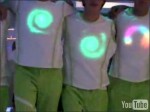

15:34 Posted in Wearable & mobile | Permalink | Comments (0) | Tags: wearable
Feb 01, 2007
Google: the future is in mobile phones
From Textually.org




[via Mad4MobilePhones] "It is clear that 2007 will be the year that mobile search query traffic grows substantially. Our current model is to use targeted text ads and we have evidence that the monetization of those ads is higher than in non-mobile uses. So it looks like the advertising revenue on a per-search query is likely to be significantly higher on mobile than on non-mobile.
As part of that, we are investing in new categories of using mobile devices. For example, YouTube content is being used and can be viewed on mobile devices in various partnerships that we're doing. Those are as much opportunistic for us, and they're not really driving revenue yet; although in theory, you could imagine a combination of video, video advertising on a mobile phone that would have the best entertainment value but also very, very high monetization rates. We're unlikely to split it out. It's not material today in a financial sense, and more importantly, it's still emerging.
We are making a significant investment in technology around mobile because of the growth rate of mobile and the ultimate scale of that business. You won't really see its financial impact until `08."
22:58 Posted in Wearable & mobile | Permalink | Comments (0) | Tags: mobile, wearable
Jan 31, 2007
BuddyCheckService helps seniors
Re-blogged from Textually.org
BuddyCheckService helps seniors that live alone keep their independence. It uses ASR speech technology to enable overtaxed family caregivers to monitor loved ones on a regular basis, and are alerted by text message or call on their mobile phone if there is an emergency.
17:15 Posted in Wearable & mobile | Permalink | Comments (0) | Tags: mobile, wearable
New mobile monitoring system from Loughborough University
Via Medgadget



Researchers at Department of Electronic and Electrical Engineering at the Loughborough University in the UK are planning to introduce a portable telemedicine technology to the market. The system enables a doctor to observe remotely up to four different medical signals from a freely moving patient. Signals that can be transmitted include the ECG, blood pressure, oxygen saturation and blood glucose level.
Now Professor Woodward has been awarded a grant by the UK-India Education and Research Initiative (UKIERI), enabling him to join forces with experts in India on the project. Working with the Indian Insitute of Technology Delhi (IIT Delhi), the All India Institute of Medical Sciences, Aligarh Muslim University and London's Kingston University, he is hoping to miniaturise the system, designing 'smart' sensors and mini-processors that are small enough to be carried by patients and able to acquire biomedical data from them. The network of sensors will be linked via a modem to mobile networks and the internet, and to a hospital computer. The device would then be used by doctors to remotely monitor patients suffering from chronic diseases, such as heart disease and diabetes, which affect millions of people across the world.
"Such a 'Mobile Disease Management System' is long overdue," says Professor Woodward. "Especially in view of the proliferation of applications in mobile data communications. It is also achievable in a three-year time frame and should provide a step-change in improving the quality of life of patients needing expert diagnoses, and for those with pre-diagnosed conditions or undergoing post-operative care.
"In the UK, the project will allow a more patient-driven health service, as promoted by the Government to improve the efficiency of health care delivery. In India, the project will link clinics and regional hospitals in remote areas to centres of excellence. As in the UK, the Indian Government is encouraging the integration of new and existing networks, much needed because of a large population spread over a vast area.
Link at Loughborough University...
00:56 Posted in Wearable & mobile | Permalink | Comments (0) | Tags: mobile, wearable
Jan 27, 2007
GPS Sneakers Send SMS to Parents if kids go off limites
From Textually.org

GTX GPS Xplorer Smart Sneakers keep track of your kids and if they wander beyond a delimited area, a GPS signal activates a text message alert to the parents phone.
13:15 Posted in Wearable & mobile | Permalink | Comments (0) | Tags: mobile, wearable
Nov 29, 2006
Driving a Wheelchair with Your Shirt
From Medgadget

Researchers Fishbach and Mussa-Ivaldi at Northwestern University's Department of Physical Medicine and Rehabilitation have developed a high-tech fabric which promises to help wheelchair bound patients.
From the article at MIT Tech Review:
Adaptive, sensor-laden garments could provide a new way for quadriplegics to control their wheelchairs. The system, which is still in an early stage of development, identifies the ideal set of movements that can be employed as control commands for each individual user. "We think this will benefit the most difficult patients, such as those who can move only their head or shoulders," says Alon Fishbach, a scientist at Northwestern who is among those developing the device.
People with high-level spinal-cord injuries often lose control of their hands, but they may still be able to move their shoulders or chests. More and more such patients survive their injuries, thanks to respiratory devices that help them breathe. But these people have limited options when selecting devices to control their wheelchairs or computers. They might use a sip/puff switch, which converts the user's sip or puff of air into a specific command, or a headswitch, which records head movements via a switch on the back of the wheelchair. "But the disadvantage of these devices is that patients must fit the capacities of the machine, rather than the other way around," says Ferdinando Mussa-Ivaldi, another Northwestern scientist working on the device. "If a patient can move their right side more than their left, an intelligent interface could pick up on this."
To overcome this design flaw, the researchers are developing an adaptive device using sensor-laden fabric. The garment is printed with 52 flexible, piezoresistive sensors developed at the University of Pisa. These sensors are made of electroactive polymers that change voltage depending on the angle at which they are stretched. The sensors can detect fine scale movements of the upper body and arms.
The researchers are currently focusing on a system to control wheelchairs, but they say the device could be used to control a wide range of machines.
21:13 Posted in Wearable & mobile | Permalink | Comments (0) | Tags: neurotechnology, wearable
Sep 21, 2006
E-garments
Via WMMNA
Philips Design has prototyped two garments that demonstrate how electronics can be incorporated into fabrics and clothes to express the emotions and personality of the wearer.
Bubelle, the "blushing dress" comprises two layers, the inner one is equipped with sensors that respond to changes in the wearer's emotions and projects them onto the outer textile. It behaves differently depending on who is wearing it. The other prototype is Frison, a body suit that reacts to being blown on by igniting a private constellation of tiny LEDs. Both measure skin signals and change light emission through biometric sensing technology.
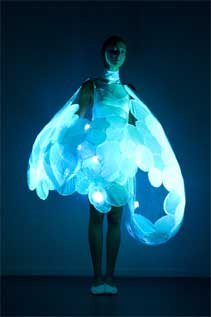

Design Probe is an in-house far-future research program that considers what lifestyles might be like in 2020.The SKIN probe project is part of the program and challenges the notion that our lives are automatically better because they are more digital. It looks at more 'analog' phenomena like emotional sensing, exploring technologies that are 'sensitive' rather than 'intelligent'. Two outfits have been developed as part of SKIN to identify a new way of communicating with those around us by using garments as proxies to convey deep feelings that are difficult to express in words.
The Bubelle - Blush Dress comprises two layers, the inner layer of which is equipped with sensors that respond to changes in the wearer's emotions and projects them onto the outer textile. The body suit Frisson has LEDs that illuminate according to the wearer's state of excitement. Both measure skin signals and change light emission through biometric sensing technology.
Download images here
Read the full press release
10:35 Posted in Emotional computing, Wearable & mobile | Permalink | Comments (0) | Tags: emotional computing, wearable
Jun 21, 2006
New wrist-worn Linux PC targets healthcare
Via Emerging Technology Trends
The Zypad WL 1000 is a new hands-free PC running Linux or Windows CE, which offers wireless networking and GPS tracking. It also includes a patented orientation sensor that can be configured to induce standby when the user's arm drops. According to the manufacter (Eurotech), the Zypad could be used by healthcare or law enforcement personnel.

Eurotech expects to have the product "on the shelf" in late July, priced at $2,500.
14:15 Posted in Wearable & mobile | Permalink | Comments (0) | Tags: wearable
Feb 19, 2006
IST Mobile Summit 2006
IST Mobile Summit 2006 is taking place 4-8 June 2006, in Myconos, Greece
The Summit will distribute the latest information covering all aspects of wireless telecommunications for systems of present and future generation to managers, researchers, hardware/software designers and other professionals in the field. The conference will also cover policy, regulation and standardisation issues, which have a key role in the introduction of operative systems and services. The conference will include invited presentations from leading experts. Several demonstrations from European and International projects will also take place, as well as exhibitions.
Visit the event's web site for more information
14:30 Posted in Wearable & mobile | Permalink | Comments (0) | Tags: Positive Technology, wearable, mobile
Oct 31, 2005
//MUKANA
Mukana is a wearable wireless device to help the visually impaired, which connects technology with textiles. The system consists of a cell phone, a wireless headset, a Global Positioning System (GPS) module and voice recognition software. Users can ask the system to tell them their location, to give information on what route to take to their destination or on the timetables of public transportation. 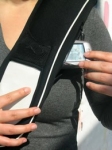 The guide system is operated with a Bluetooth® enabled wireless headset and an integrated 10-key Braille number pad for the visually impaired. Extra batteries are included to guarantee the long-term functioning of the system and the cell phone. There is a pocket where the headset can be charged and stored, as well as a pocket for keys and a wallet. The Braille keypad is located in front of the garment, rotated 90 degrees from the normal position to support ergonomic hand movement.
The guide system is operated with a Bluetooth® enabled wireless headset and an integrated 10-key Braille number pad for the visually impaired. Extra batteries are included to guarantee the long-term functioning of the system and the cell phone. There is a pocket where the headset can be charged and stored, as well as a pocket for keys and a wallet. The Braille keypad is located in front of the garment, rotated 90 degrees from the normal position to support ergonomic hand movement.
18:15 Posted in Wearable & mobile | Permalink | Comments (0) | Tags: Positive Technology, wearable
Lost in translation? Get CMU translation goggles
via Engadget
Researchers from the International Center for Advanced Communication Technologies (interACT), a joint venture of Carnegie Mellon and the University of Karlsruhe, have developed a wearable system, which allows real-time speech translation. 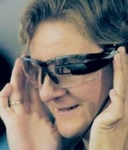 The system consists of consists of 11 electrodes that detect mouth muscle movements, translates that to a spoken language, and then re-translates that into other languages. According to comp-sci professor Alex Weibel, director of inteACT, the system still makes mistakes, he is confident that researchers will improve it significantly in the next five years. "It will make communication and cultural learning more likely" since people using this technology will be empowered to come together when they wouldn't otherwise interact, Waibel said.
The system consists of consists of 11 electrodes that detect mouth muscle movements, translates that to a spoken language, and then re-translates that into other languages. According to comp-sci professor Alex Weibel, director of inteACT, the system still makes mistakes, he is confident that researchers will improve it significantly in the next five years. "It will make communication and cultural learning more likely" since people using this technology will be empowered to come together when they wouldn't otherwise interact, Waibel said.
17:05 Posted in Wearable & mobile | Permalink | Comments (0) | Tags: Positive Technology, wearable
Oct 19, 2005
On-the-Move Interaction with Everyday Objects
MIT researchers have designed and developed a bracelet called ReachMedia that is able to identify objects the user is holding and then to connect to the Internet, to search information concerning these objects. The system is also able to detect and recognize hand gestures through an integrated accellerometer, allowing the user to interact with available information.

More to explore
ReachMedia: On-the-Move Interaction with Everyday Objects, International Symposium on Wearable Computers (ISWC'05), Osaka Japan, October 18 - 21, 2005
14:45 Posted in Wearable & mobile | Permalink | Comments (0) | Tags: Positive Technology, wearable







